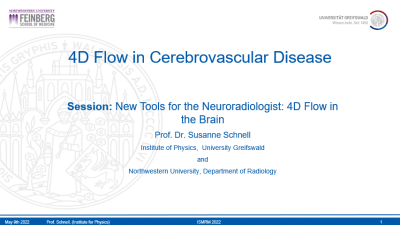4D Flow in Cerebrovascular Disease: How Do We Do It?
Susanne Schnell1
1University of Greifswald, Germany
1University of Greifswald, Germany
Synopsis
4D flow MRI is a phase-contrast MRI method that is time-resolved, acquired in 3D, and uses 3-directional velocity encoding to fully resolve the 3-dimensional velocity vector. Data analysis involves the correction of noise and errors, vessel segmentation, and data visualization. Applications in cerebrovascular disease include aneurysms, atherosclerotic disease, arterial-venous malformation (AVM), as well as Alzheimer's disease. Hemodynamic parameters such as flow rate, peak velocity, relative pressure, or pulsatility can be calculated from the 4D flow MRI raw data to assess e.g. the severity of stenosis or blood flow redistribution after embolization of an AVM.
